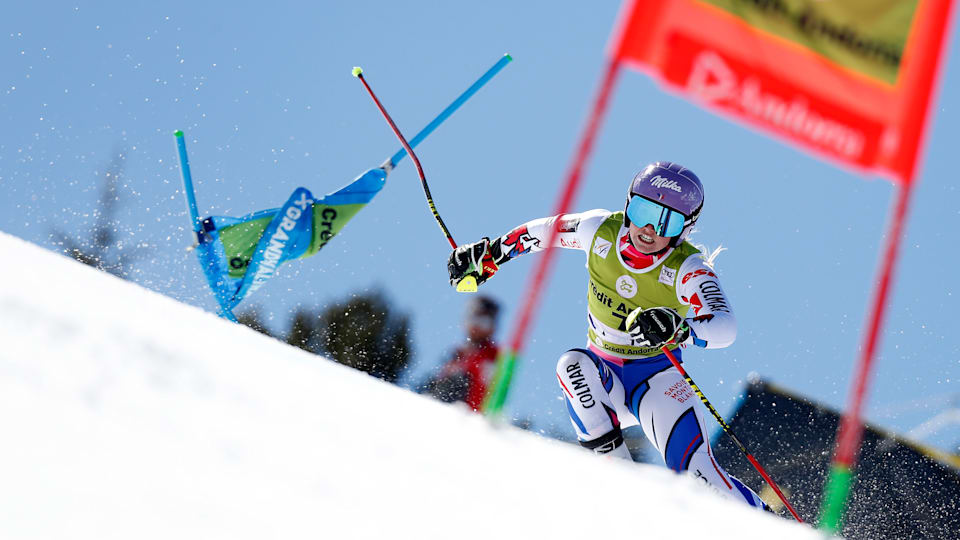
Alpine Skiing: the popular pastime that is so difficult to master.
That is why spectators attend Alpine events in their droves every winter, as pro skiers slalom down slopes at near unfathomable speeds.
It's for this reason alpine skiing makes for incredible viewing, and you will be able to watch the thrill-a-minute action at the Lausanne 2020 Winter Youth Olympic Games in January.
But do you know your slalom from your giant slalom? And what makes up the alpine combined event?
Discover more about the five Alpine Skiing disciplines on show at Lausanne 2020, and find out which athletes the next crop of YOG competitors will be hoping to emulate.
How to watch Alpine Skiing at Youth Olympic Games
Olympic Channel will stream 300 hours of action from the 13 days of competition in Lausanne 2020 with a dedicated Winter YOG channel available on olympicchannel.com, YouTube and connected devices such as Amazon Fire, Apple TV, Android TV and Roku.
There will be an action-packed daily live show featuring news, highlights, trending stories and interviews in a fun and interactive format streamed on Facebook, Twitter and olympicchannel.com, plus a daily Olympic Channel Podcast featuring insightful interviews with personalities from across the Olympic world.
Fans can also follow Olympic Channel's coverage on Facebook, Twitter, Instagram and YouTube to learn more about the event, while a full schedule of events - including online streaming details can be found here.
Alpine Skiing location and dates
The alpine skiing takes place in Diablerets from January 10-15 at Lausanne 2020. (Scroll down for the full schedule)
Slalom vs Giant Slalom vs Super G
There will be five alpine skiing events taking place at Lausanne 2020; slalom, giant Slalom, Super-G, alpine combined and Parallel Mixed Team.
The slalom sees skiers race down two different courses, with their times combined for an overall score. This discipline requires quick turns through gates – alternating between pairs of red and blue poles – which are placed closely together.
For this reason, you will often see skiers clip the poles as they go down, which is known as cross-blocking. Miss one gate, however, and the athlete is disqualified.
In the giant slalom, skiers race between sets of poles, with the gates further apart than slalom. It follows a similar format with the times combined from two runs.
The Super-G increases the distance between the gates, making it the fastest of the three events as there are fewer sharp turns. Unlike the other two disciplines, however, Super-G consists of one single run.
There is no downhill at the Youth Olympic Games.
The Alpine Combined tests both technique and speed as it consists of two runs – Super-G and slalom. The times are combined for an overall total, with the Super-G going first.
The Parallel Mixed Team Event is all about head-to-head racing between nations (one male and one female per team), as skiers slalom around gates with the aim of crossing the finish line before their opponent.
The knockout format starts at the 1/8 finals stage. The nation with the most points (one for a win, zero for a loss) after four runs reaches the next round.
Petra Vlhova: The shining light
If YOG skiers are looking for inspiration, they need look no further than Slovakia’s first alpine skiing world champion, Petra Vlhova.
The step-up from youth to senior competition is never easy, but Vlhova has certainly made her mark after impressive results at junior level.
The 24-year-old won Slalom gold at the 2012 Youth Olympic Games in Innsbruck, and was crowned the junior world champion two years later.
After picking up four World Cup wins between 2016 and 2018, 2019 proved to be a year to remember for Vlhova.
She ranked second behind Mikaela Shiffrin in the overall World Cup standings, placing second in the Slalom and Giant Slalom too.
But it was at the World Championships in Are where Vlhova made history, taking home Slovakia’s first gold in the Giant Slalom, beating Viktoria Rebensburg and Shiffrin to top the podium.
Vlhova also won silver in the Combined and bronze in the Slalom, proving she is a force to be reckoned with, and set to challenge Shiffrin for further glory in the years to come.
Marco Schwarz is also on the right path. The Austrian won three gold medals at the 2012 Youth Olympic Games.
He went on to claim silver in the Team Event at Pyeongchang 2018, and took his first two World Cup wins last season before collecting three medals at the 2019 World Championships – silver in the Team Event and bronze in both the slalom and combined.
Alpine Skiing schedule in Lausanne
Friday, January 10
10:15 - 11:30 - Women's Super-G
13:30 - 15:00 - Men's Super-G
Saturday, January 11
10:30 - 11:30 - Men's Alpine Combined
12:30 - 13:30 - Women's Alpine Combined
Sunday, January 12
10:00 - 11:30 - Women's Giant Slalom Run 1
12:45 - 14:15 - Women's Giant Slalom Run 2
Monday, January 13
10:00 - 11:30 - Men's Giant Slalom Run 1
12:45 - 14:15 - Men's Giant Slalom Run 2
Tuesday, January 14
09:30 - 11:00 - Women's Slalom Run 1
11:00 - 12:30 - Men's Slalom Run 1
13:45 - 15:00 - Women's Slalom Run 2
15:00 - 16:15 - Men's Slalom Run 2
Wednesday, January 15
11:00 - 12:30 - Parallel Mixed Team Event
